Cross Cap Bon, Explore Kerkoune and Travel to Hammanet
After breakfast today, we took a scenic drive along Cap Bon ("the beautiful peninsula") on the Mediterranean coast, stopping en route to Kerkouane. This notable archeological site features ruins that date back to the third and fourth centuries BC, when this was a Punic city in the times of ancient Carthage. While Carthage was destroyed by the Romans at the end of the Punic Wars and subsequently rebuilt in Roman fashion, Kerkouane escaped this ill fate, so that ruins that we found here were an accurate representation of an ancient Punic city, and shed light on what the famed city of Dido originally looked like.
Considering its excellent location, next to the sea right here on the tip of Africa, about as close as you can get to Europe, it is mystery why the Romans never used it to build their own town. Kerkouane has surprised archaeologists by its almost complete lack of grand public buildings.
Archaeologists still work on the Kerkouane site. The economy of Kerkouane was based on the
manufacture of purple dye, one of the most valued colors and used in many European countries only by royals. Shellfish known as murex were caught along the coast and placed in pits in the ground to rot. Kerkouane has been classed by UNESCO as a World Heritage Site.
Our attention was first drawn to the outer protective wall that can still be observed.
The second protective wall was the outer walls of the homes.
The layout is clearly visible and many houses still show their walls. In a few places the colored
clay on the facades has survived. Houses of Kerkouane were all built according to the same patterns, usually secluded from the street and with a courtyard in front. Rooms were located In front the courtyards. House walls were built according to a typical style for North Africa, with rubble set in between larger upright stones holding the structure together, a technique, called opus africanum by the Romans.
Many of the rooms at Kerkouane have a mosaic floor of a simple but quite beautiful design . Some have the fertility symbol of the goddess Tanit. A few of the houses are believed to have been of two stories. Many of the houses have nice red floors, which were made from old pottery and set with small marble chips. The main streets were very wide. Private baths were not public but rather part of a family's house.
These were probably used by the workers to clean up. Bathtubs were often made with a red or pink
plaster or a sort of cement.
The settlement was built close to the sea.
We had lunch at Toro Fish Restaurant in Kelibia (located very bottom of map above)
Fish soup, fresh bread (Phoenician), fish & chips, strawberries
And warm sweet tea (above)
Fishing ships in the harbor at Kelibia
Nearby “football” practice
Next stop was nearby Nabuel (just north of Hammanet on map), a former Roman colony.
Nabuel is the main center of the Tunisian pottery industry. Pottery symbols adorned street intersections
We visited a pottery workshop that actually was producing pottery. Good stop, more than
surface demonstrations.
Smashed windows and shored up protection was evidence that the revolution took place here also.
We moved on to Hammamet where our bus parked by the Medina, which dates back to 1500. We were given free time to roam.
A little boy tried to sell me a rose. Persistent fellow.
Waterfront activity
Hotel Mehari Hammamet
Lobby
Atrium
Restaurant
Fred’s balcony
Pool
DAY 6 SATURDAY. May 7th Travel to Kairouan
Introduction to Islam Home-hosted lunch
After a comprehensive breakfast we met in the lobby for an 8:30 am departure.
Today we left Tunisia's seacoast and journeyed inland to Kairouan RG Map p. 245; info pp. 244-246;
LP pp. 173-179; IG Map p. 240 and info pp. 239-244. a city with a spiritual feel whose domed mosques
and minarets we saw from afar. This holiest of Tunisian cities was founded in AD 670 by Oqba ibm Nafi (disciple of Prophet Mohammed) who, according to legend, slipped on a golden cup that came from Mecca and was hidden in the sand at the spot where Kairouan is now located. When he picked up the cup, water allegedly burst forth from the ground.
Our first stop in the city took us to a building overlooking two large water reservoirs called
"Aghlabid basins." It was a little windy up there.
A short distance away was the Sisi Sahbi Mausoleum. This complex stands outside the medina, on the site of the tomb of one of the Prophet’s companions, Abu Zama'a al-Balawi, known as Sidi Sahbi, the city’s patron.
We entered through the ornate gate and found ourselves in a rectangular courtyard. Here an
apprehensive young boy, accompanied by his parents, was waiting to be circumcised at this “sacred” place.
Our main objective of the day was the Great Mosque (RG outline p. 249) which dates from early in the Islamic period and is the fourth-holiest site in Islam after Mecca, Medina, and the Dome of the Rock in Jerusalem. According to Rough Guide xix, four trips here is as good as a pilgrimage to Mecca. With its
enormous buttressed walls, sturdy ornamental gates, three-tiered minaret, the mosque looks more like a military stronghold than a place of devotion.
The minaret is shown below
The court yard was used as a catchment area, with rainwater channeled to the curiously shaped drain in the center and into huge cisterns below. Neither the minaret nor the courtyard is symmetrical, which is in
contrast to the layout of the prayer hall.
Mohamed points to the prayer hall which we were not permitted to enter. Muslim women entered a separate door to a cordoned off area to keep them segregated from the men.
We next had an exclusive discussion giving us an Introduction to Islam with an Imam at this mosque.
Kairouan was the focus of resistance to ex-president Bourguiba’s efforts to secularize Tunisia in the 1960s.
OAT members submitted questions to Mohamed who in turn interpreted the questions for the Imam. I thought the questions were thoughtful, like: Why are the Christians being persecuted in Egypt and who will be saved? The moderation expressed by Mohamed about Islam was really not a result of the teachings from the Koran, but rather from decrees from the secular authorities. The equality of the sexes and equal opportunities were not promoted by the Koran. Nor does the Koran teach that all religions have the same god with only different names.
Actually the Koran teaches: “The messiah Jesus, the sonof Mary, was no more than God’s apostle... God
forbid that He Himself should beget a son” (Koran 4:171). In the Muslim Koran, Christ did not rise from the dead: “They did not kill him, nor did they crucify him, but they thought they did... They did not slay him for certain” (Koran 4:156-158). The Koran further states that Christ is not God and should not be worshipped “instead of God” (Koran 3:47). In the religion of Islam, the unworthy who do not totally submit to Allah, face real hell (Koran 4:13). Many, if not most, of the verses in the Koran threaten hellfire if your works are not sufficient.. To say that the Koran teaches religious toleration is deceptive. Tunisians are tolerate because they had a strong leader (like Ataturk in Turkey) who imposed secular reform. Yet, the session was interesting. Mohamed is representative of the many peaceful moderate Muslims so prevalent today in Morocco, Tunisia and Turkey
We observed a special glimpse of everyday Tunisian culture during a home-hosted lunch with a local family . When handling food we used our right hand because the left hand is used for wiping bottoms in Tunisia. Lonely Planet p. 53 suggested that we eat up all of our food and don’t refuse if someone offers more. The family that hosted us were gracious and extremely friendly
Our meal included turnovers (brik) with onion and tuna enclosed. Very tasty.
Followed by a lamb plate with beans and pepper.
The lady of the house had a wonderful sense of humor and did a great impersonation of Muammar Gaddafi.
They passed out family photos, which included this one of a bride.
Then a large map was pulled out for all of us to sign our name and to designate our home city.
After lunch we learned about Kairouan's long history as a carpet-making center. When we entered the city from the north we saw a monument in a round-about that indicated the importance of that industry here.
During a visit to the usual carpet workshop, where we watched a token demonstration of this ancient craft and learned the difference between knotted carpets and woven carpets. See LP p. 179 about carpet buying. Rough Guide, p. 253.
Then we moved into the salesroom to view carpeting that was offered for sale. The salesman was very
pleasant and a number of our group were interested buyers..
We checked in at the conveniently located LaKasbah Golden Yasmin Hotel RG Map p. 245;
Located in Kairouan's kasbah and one of the few hotels inside the city's ancient walls, the hotel offers beautiful Islamic architecture. Along with its two restaurants, Turkish cafe, and outdoor pool, this 94-room hotel offers air-conditioned rooms featuring satellite TV, telephone, minibar, safe and private bath. Rough Guide, p. 247, calls it the city’s only top-notch hotel and gives it five stars. LP p. 178 lists it as top end.
Buffet dinner at the hotel was included.
DAY 7, SUNDAY, May 8th
At leisure in Kairouan or Optional El Djem & Monastir tour
We started off the morning with a nice breakfast. This morning I joined the optional tour, as did most of our group.
The optional excursion started off by heading to Monastir on the coast.
En route Mohamed had the bus pull over so we could photograph some flamingoes on a pond.
On the outskirts of Monastir, I caught sheep with my camera from the bus. Then we passed through a residential area with handsome homes that had been given to relatives of the late president’s wife (that
angered many with this misuse of public funds).
Then we reached the ribat, an example of well-conducted reconstruction with an ancient atmosphere. A ribat was a cross between a fort and a monastery. Islamic warriors occupied them. Most have now disappeared, with the notable exception of Sousse and Monastir LP p. 43.
The area around the lookout tower, or nador, is the oldest part. The walls to the south of this part are from the 9th century, while the northern walls date back to the 11th century. Some small areas belong to the 18th and 19th centuries. But there is more that challenge the feeling of authenticity: Today the courtyard is filled with chairs as well as a stage for evening performances.
If the complex looks familiar it’s because film directors like the Islamic architecture. Many scenes from Monty Python’s Life of Brian was filmed here. The site was also used in Life of Christ and Jesus of Nazareth.
View of the harbor
Then we visited the nearby Mausoleum of the revered first president of Tunisia. Habib Bourguiba is often compared to Turkish leader Ataturk because of the pro-western reforms enacted during his presidency. Bourguiba history and modern history: See IG pp. 60-75.
Here we see a mosque shaped structure at the entrance to the complex.(LP pp. 170-172)
Here is proof how dead serious he actually took himself. Within three years of his coming to power $12 million had been spent on his home town, one-eighth of Tunisia’s annual budget at the time. Money that this country could have used so much better in other areas, had been put into making Monastir, the birthplace of Bourguiba, into his mausoleum. He chose the centre of town where a cemetery was located and relocated the bones from a section of the cemetery. Buildings were also torn down for the project.
He added minarets to either side of the tomb. They did not function as minarets but served only ornamental purposes.
The central structure was this domed-like building.
Inside was his final resting place
Among the items in the museum was a pen given to him by Ronald Reagan
Photo of Bourguiba on exhibit
We visited the birthplace and home of Bourguiba who changed the lives of women in Tunisia. Before gaining independence from France in 1956, women were restricted to stay at home. He encouraged education, restricted arranged marriages, banned polygamy, and forbad the veiling of women at academic institutions. He called the veil an “odious rag” and regarded it as demeaning. His code set a
minimum age of 17 for girls for marriage and gave them the right to refuse a proposed marriage. Currently, it is common to see women in any profession and very rare to see them veiled. 20% of parliament is reserved for women parliamentarians. The government requires parents to send girls to school, and today more than 50% of university students are women and 66% of judges and lawyers are women. Women’s place: See IG pp. 83- 84 and LP p. 40.
View of ribat and waterfront from Bourguiba’s childhood home .
I am not a great fan of shopping stops, but again we had a very good one, even for us non-shoppers. Mosaics played a big role in the early Tunisian history and still has an appeal today.
The young lady employees assembling the mosaics were delightful
Phoenician Restaurant for lunch. Mohamed explained the choices
Lamb and beans in hot sauce
Depart Monastir southward to El-Djem
Visit to El-Djem RG Map p. 265; info pp. 264-266 and 492; LP pp. 181-18; IG pp. 251-253, home to
the third-largest ancient Roman amphitheater in the world, which soars impressively above the low-rise buildings of the town's medina. This is the best-preserved Roman structure in Africa and a UNESCO World Heritage Site.
It is 148 meters long by 122 meters wide, with tiers up to 35 meters. One area of the walls is gone because in 1695 a big hole was shot in the wall of the colosseum in order to uncover the hiding places of dissidents against the Ottomans.
It's believed to have given room for as many as 30,000 spectators, some estimates set it at 45,000. This is the town of Thysdrus with only 30,000 inhabitants, but it was a wealthy town eager to impress visitors. The building process is even more impressive considering that the stones were quarried 30 km away at Salakta.
The upper part of the tiers were used as a sort of VIP tribune, where roofed rooms allowed comfort from the hot sun.
Underneath the arena run two passageways where animals, prisoners and gladiators were kept just until
the moment when they were brought up to perform what was in many cases the last show of their lives.
Armed gladiators who were mostly prisoners or criminals were in plentiful supply. They were surrounded by a macabre sort of glamour: (IG p. 231,264).
A Roman Villa has been transported in its entirety from a site in the middle of El Jem and rebuilt using original materials. The opulent villa,complete with courtyard gardens and pool, covers over three thousand square meters.
Lodging La Kasbah Hotel
DAY 8,MONDAY, May 9th
Travel to Tozeur/Visit Sbeitla & Gafsa
After a 7am breakfast today we departed Kairouan at 8 am to see a dramatic transition from green
landscapes alive with olive groves to great arid expanses of desert dotted with scattered oases.
Our bus pulled over for a photo stop in Hajeb Layoun because of a monument featuring the arms of a woman and a man depicting the theme of pulling together.
I used this stop to photo the ubiquitous cacti.
At the same site we observed a charcoal production operation
As we continued onward, I shot some sheep through the bus window. Mohamed used the driving time to explain why Nov. 7th monuments (erected for the exiled leader) will be changed to Jan. 14th (date of the revolution).
During our full day transfer we made our stop at Sbeitla RG Map p. 329; info pp. 327-331, LP pp. 152-154; IG pp. 202-203 where we visited the impressive ruins of an ancient Roman town. The first ruins we came upon were those of the Triumphal Arch commemorating the four emperors that governed the empire in the year 300, just before the rule of Constantine. In the background, as seen though the archway, were the other major sites
On this map the Triumph Arch is on the lower right. We will work our way upward to the Grand Forum.
After paying the usual fee for camera use, we crossed the street to the Byzantine Ruins (above). The arrival of the Byzantines inaugurated a new period of splendor. The Prefect Gregory moved his capital there from Carthage in the seventh century, and declared independence from Byzantium . However, only a year later the city was sacked by the first Arab invaders, and Gregory was killed.
We continued onward
to the Reservoir
We walked over toward the Gate of Antoninus, which stands at the entrance to the forum and can be dated between 138 and 161. Its inscriptions make reference to Antonius Pius and his two adopted sons, Lucius Verus and Marcus Aurelius. It is clearly among the finest arches of any site in Tunisia, and adds a dramatic effect to the arrival to the Forum. It was never finished, to which the rough surface of the four columns in front testifies.
To our right was the Byzantine Church of St. Servus
We entered the Arch of Antonius and observed the Grand Forum, the most impressive part of the entire site with its three intact temples in the center.
The southernmost of the three temples was dedicated to Minerva, who was the daughter of the two gods revered in the other two temples. She was considered to be the virgin goddess of warriors, poetry, medicine, wisdom, commerce, crafts and inventor of music. Her temple appears as the most impressive of the three from the outside, and even the interior is in excellent condition. The niche in the middle had a statue of the goddess.
The Temple of Jupiter stands in the middle, being the temple of the most important of all gods in the Roman pantheon. It is the largest temple. Since the temple has no entrance by itself, it was entered by bridges across arches from either of the other two temples. As it stands now, the most interesting detail to take in for those climbing the Capitol, are the underground chambers which cannot be entered, but viewed from above. Jupiter's temple has no niche for the god statue. Still there must have been one, probably placed in the middle of the floor.
The Temple of Juno on the far right is by far the least impressive of the three making up the Capitol. It is also the most deteriorated one. Juno was the Queen of the gods, the wife of Jupiter and the mother of Minerva. The niche in the middle had a statue of the goddess but it has never been found.
Now we went over to the fine selection of baths in Sbeitla, some small and rather private in nature. The most impressive are the Great Baths, where large mosaic floors have survived almost intact from the original state. The Great Baths date back to the 3rd century CE.
The two main sections are the cold baths and the warm baths with under-floor heating system.
Connected to the baths are also the sporting grounds known as Palaestra. The Palaestra is noted for its fine floor mosaics.
Even though the theatre is in a poor state of preservation it is worth a detour, as much for its picturesque location as anything else since it stands on the Oued Sbeitla ravine.
The tiers are being rebuilt but the orchestra pit is still clearly visible, as are some of the colonnades
around the stage, which drops away towards the ravine.
Mission accomplished.
Lunch break at a fancy place
Soup, salad, chicken, tomatoes and potatoes
After lunch we continued on through the oasis town of Gafsa RG Map 343; info pp. 340-346; LP 333-335 Upper right on map below.
Road to Gafsa
Shot of school girls from the bus
Roundabout sculptures in Gafsa (photo from the bus)
Road to Tozeur
City Gate of Tozeur Map 355; info 354-355; LP 223-229. This ancient city occupies a four-square-mile
oasis of 250,000 date palms whose green lushness stands in stark contrast to the surrounding Sahara.
I engaged in people watching in Tozeur.
Nestling in a magnificent garden facing Tozeur's palm oasis, beside the majestic landscapes of the desert, the Golden Yasmin Ras El Aïn Tozeur provided a cool and comfortable stay in the heart of the Tunisian south.
We were greeted with the customary welcome drink.
My room was spacious
Our included dinner at the hotel was outstanding.
GO ON TO 2011 TUNISA PART III: Salt Flats, Sahara Desert, Mountains & Bedouins
















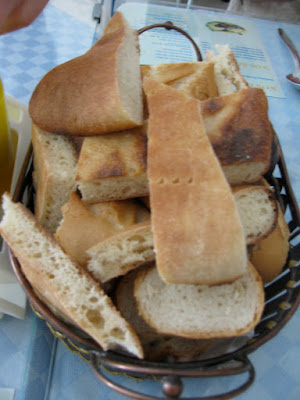



















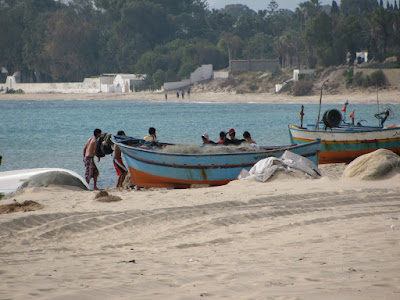











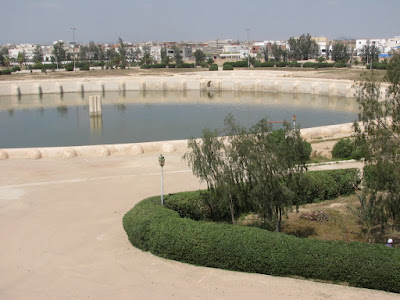




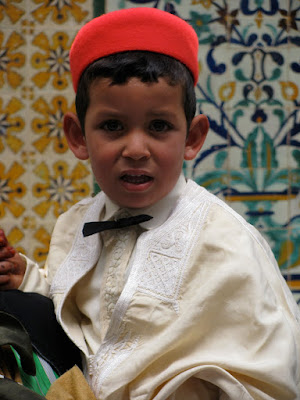







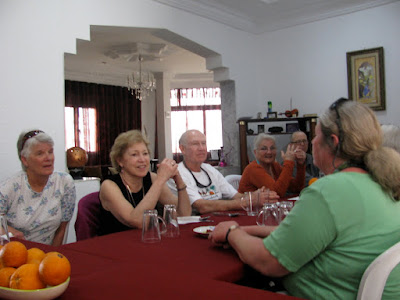


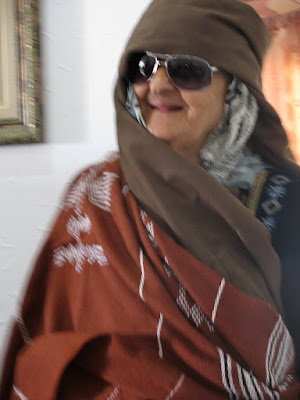


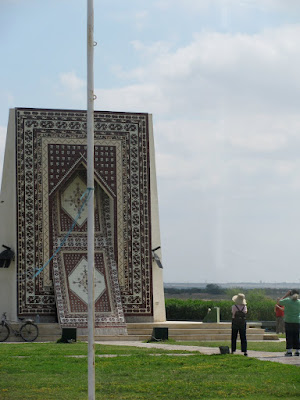




























































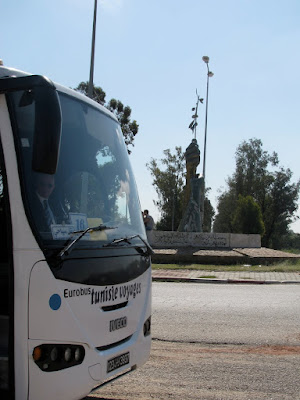




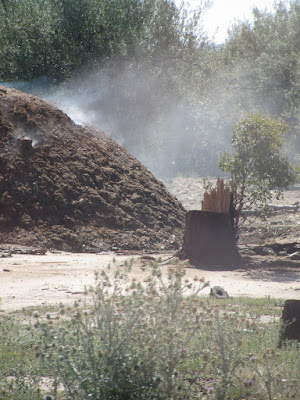




















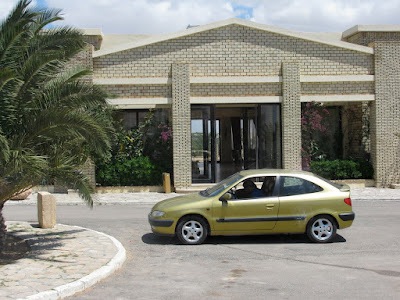















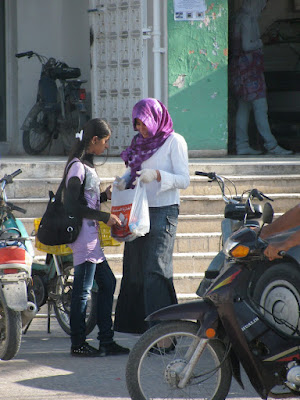







No comments:
Post a Comment